Sustainable Tourism Development in Qatar: Planning and Impact Analysis
VerifiedAdded on 2020/06/05
|13
|4150
|144
Report
AI Summary
This report provides a comprehensive analysis of sustainable tourism development in Qatar. It begins with an introduction to the tourism sector's growth and its challenges in achieving sustainable development goals, particularly in a developing country like Qatar. The report then covers various aspects of tourism planning, including international, national, and regional levels, and emphasizes the importance of collaborative development. It explores methods for measuring tourism's impact, such as the Cambridge Economic Impact Model, environmental impact studies, and social impact studies. The report also justifies the need for sustainability in tourism, discussing the Brundland Report and the Triple Bottom Line framework. It evaluates factors that may hinder sustainable tourism development, including education levels, climate change, and political factors. Finally, it analyzes the stages involved in planning for sustainability, such as assessing tourism demand and supply and determining objectives. The report offers valuable insights into the strategies and challenges of fostering sustainable tourism in Qatar.
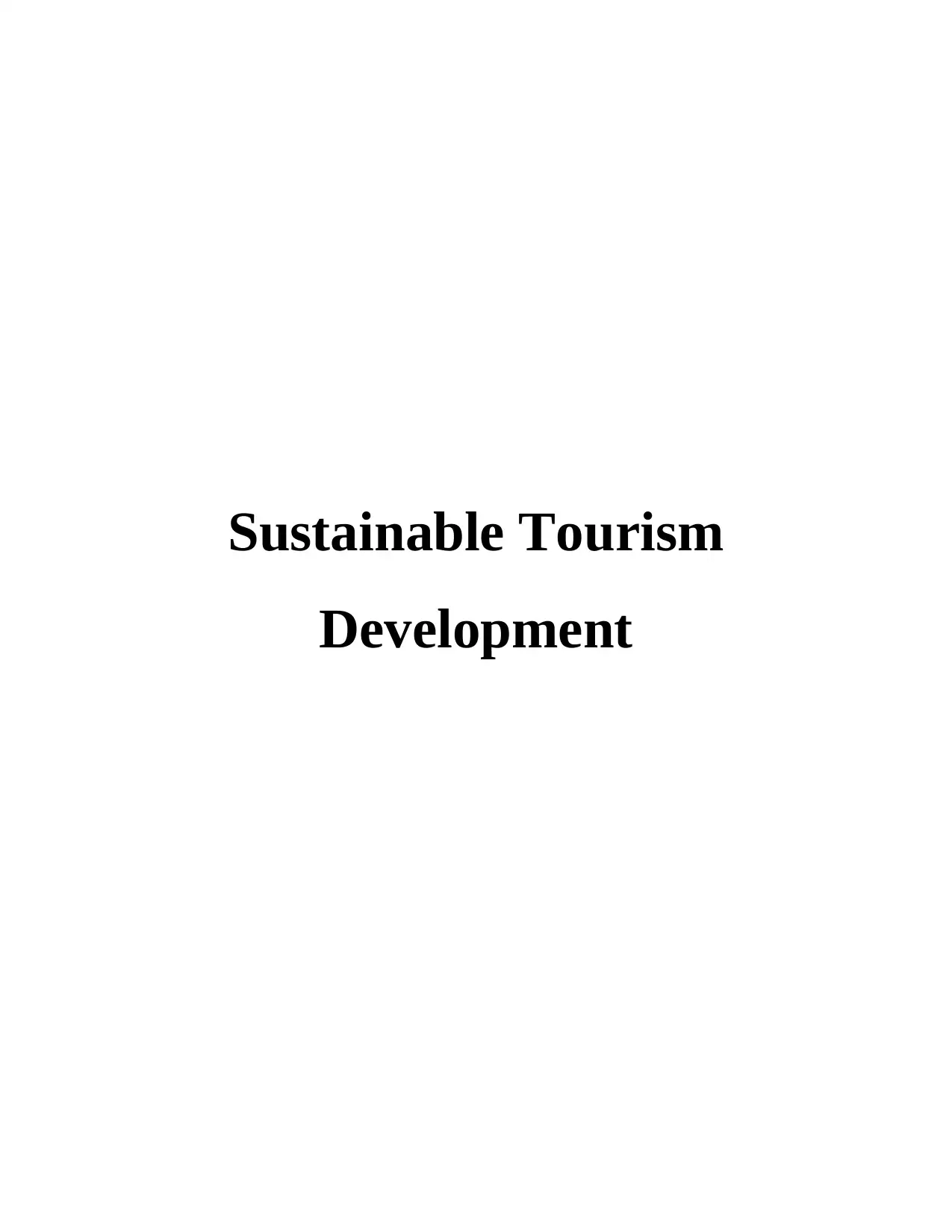
Sustainable Tourism
Development
Development
Paraphrase This Document
Need a fresh take? Get an instant paraphrase of this document with our AI Paraphraser
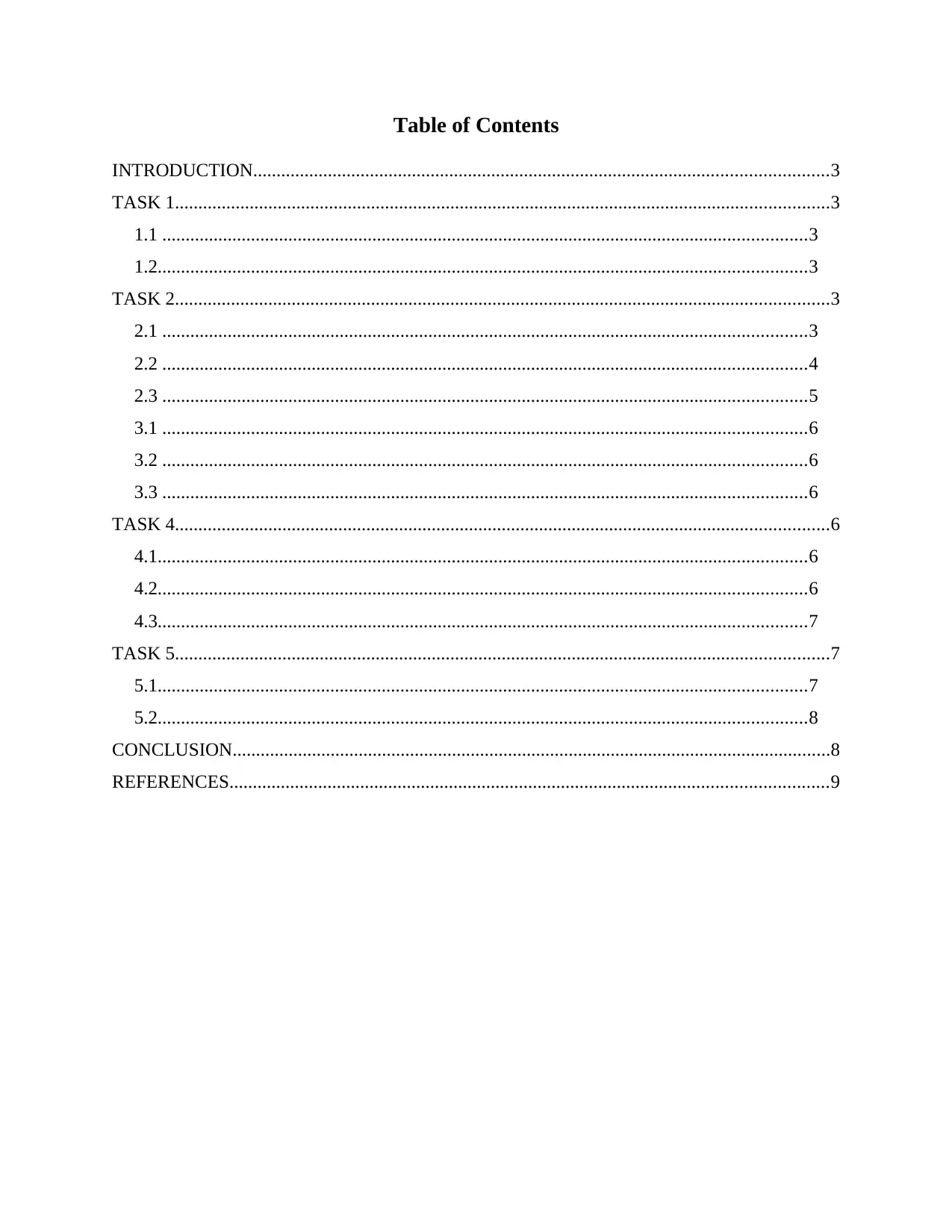
Table of Contents
INTRODUCTION...........................................................................................................................3
TASK 1............................................................................................................................................3
1.1 ..........................................................................................................................................3
1.2...........................................................................................................................................3
TASK 2............................................................................................................................................3
2.1 ..........................................................................................................................................3
2.2 ..........................................................................................................................................4
2.3 ..........................................................................................................................................5
3.1 ..........................................................................................................................................6
3.2 ..........................................................................................................................................6
3.3 ..........................................................................................................................................6
TASK 4............................................................................................................................................6
4.1...........................................................................................................................................6
4.2...........................................................................................................................................6
4.3...........................................................................................................................................7
TASK 5............................................................................................................................................7
5.1...........................................................................................................................................7
5.2...........................................................................................................................................8
CONCLUSION................................................................................................................................8
REFERENCES................................................................................................................................9
INTRODUCTION...........................................................................................................................3
TASK 1............................................................................................................................................3
1.1 ..........................................................................................................................................3
1.2...........................................................................................................................................3
TASK 2............................................................................................................................................3
2.1 ..........................................................................................................................................3
2.2 ..........................................................................................................................................4
2.3 ..........................................................................................................................................5
3.1 ..........................................................................................................................................6
3.2 ..........................................................................................................................................6
3.3 ..........................................................................................................................................6
TASK 4............................................................................................................................................6
4.1...........................................................................................................................................6
4.2...........................................................................................................................................6
4.3...........................................................................................................................................7
TASK 5............................................................................................................................................7
5.1...........................................................................................................................................7
5.2...........................................................................................................................................8
CONCLUSION................................................................................................................................8
REFERENCES................................................................................................................................9
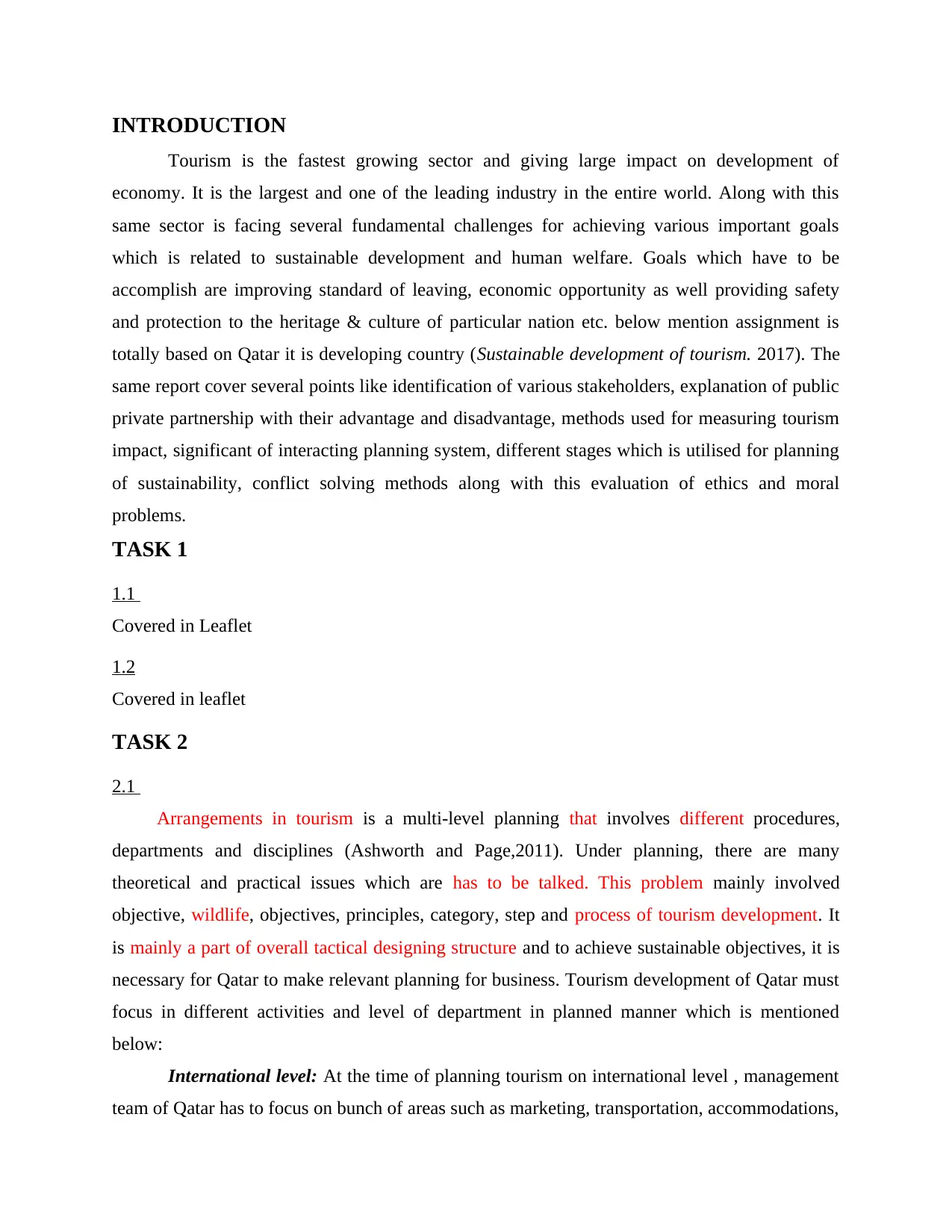
INTRODUCTION
Tourism is the fastest growing sector and giving large impact on development of
economy. It is the largest and one of the leading industry in the entire world. Along with this
same sector is facing several fundamental challenges for achieving various important goals
which is related to sustainable development and human welfare. Goals which have to be
accomplish are improving standard of leaving, economic opportunity as well providing safety
and protection to the heritage & culture of particular nation etc. below mention assignment is
totally based on Qatar it is developing country (Sustainable development of tourism. 2017). The
same report cover several points like identification of various stakeholders, explanation of public
private partnership with their advantage and disadvantage, methods used for measuring tourism
impact, significant of interacting planning system, different stages which is utilised for planning
of sustainability, conflict solving methods along with this evaluation of ethics and moral
problems.
TASK 1
1.1
Covered in Leaflet
1.2
Covered in leaflet
TASK 2
2.1
Arrangements in tourism is a multi-level planning that involves different procedures,
departments and disciplines (Ashworth and Page,2011). Under planning, there are many
theoretical and practical issues which are has to be talked. This problem mainly involved
objective, wildlife, objectives, principles, category, step and process of tourism development. It
is mainly a part of overall tactical designing structure and to achieve sustainable objectives, it is
necessary for Qatar to make relevant planning for business. Tourism development of Qatar must
focus in different activities and level of department in planned manner which is mentioned
below:
International level: At the time of planning tourism on international level , management
team of Qatar has to focus on bunch of areas such as marketing, transportation, accommodations,
Tourism is the fastest growing sector and giving large impact on development of
economy. It is the largest and one of the leading industry in the entire world. Along with this
same sector is facing several fundamental challenges for achieving various important goals
which is related to sustainable development and human welfare. Goals which have to be
accomplish are improving standard of leaving, economic opportunity as well providing safety
and protection to the heritage & culture of particular nation etc. below mention assignment is
totally based on Qatar it is developing country (Sustainable development of tourism. 2017). The
same report cover several points like identification of various stakeholders, explanation of public
private partnership with their advantage and disadvantage, methods used for measuring tourism
impact, significant of interacting planning system, different stages which is utilised for planning
of sustainability, conflict solving methods along with this evaluation of ethics and moral
problems.
TASK 1
1.1
Covered in Leaflet
1.2
Covered in leaflet
TASK 2
2.1
Arrangements in tourism is a multi-level planning that involves different procedures,
departments and disciplines (Ashworth and Page,2011). Under planning, there are many
theoretical and practical issues which are has to be talked. This problem mainly involved
objective, wildlife, objectives, principles, category, step and process of tourism development. It
is mainly a part of overall tactical designing structure and to achieve sustainable objectives, it is
necessary for Qatar to make relevant planning for business. Tourism development of Qatar must
focus in different activities and level of department in planned manner which is mentioned
below:
International level: At the time of planning tourism on international level , management
team of Qatar has to focus on bunch of areas such as marketing, transportation, accommodations,
⊘ This is a preview!⊘
Do you want full access?
Subscribe today to unlock all pages.

Trusted by 1+ million students worldwide
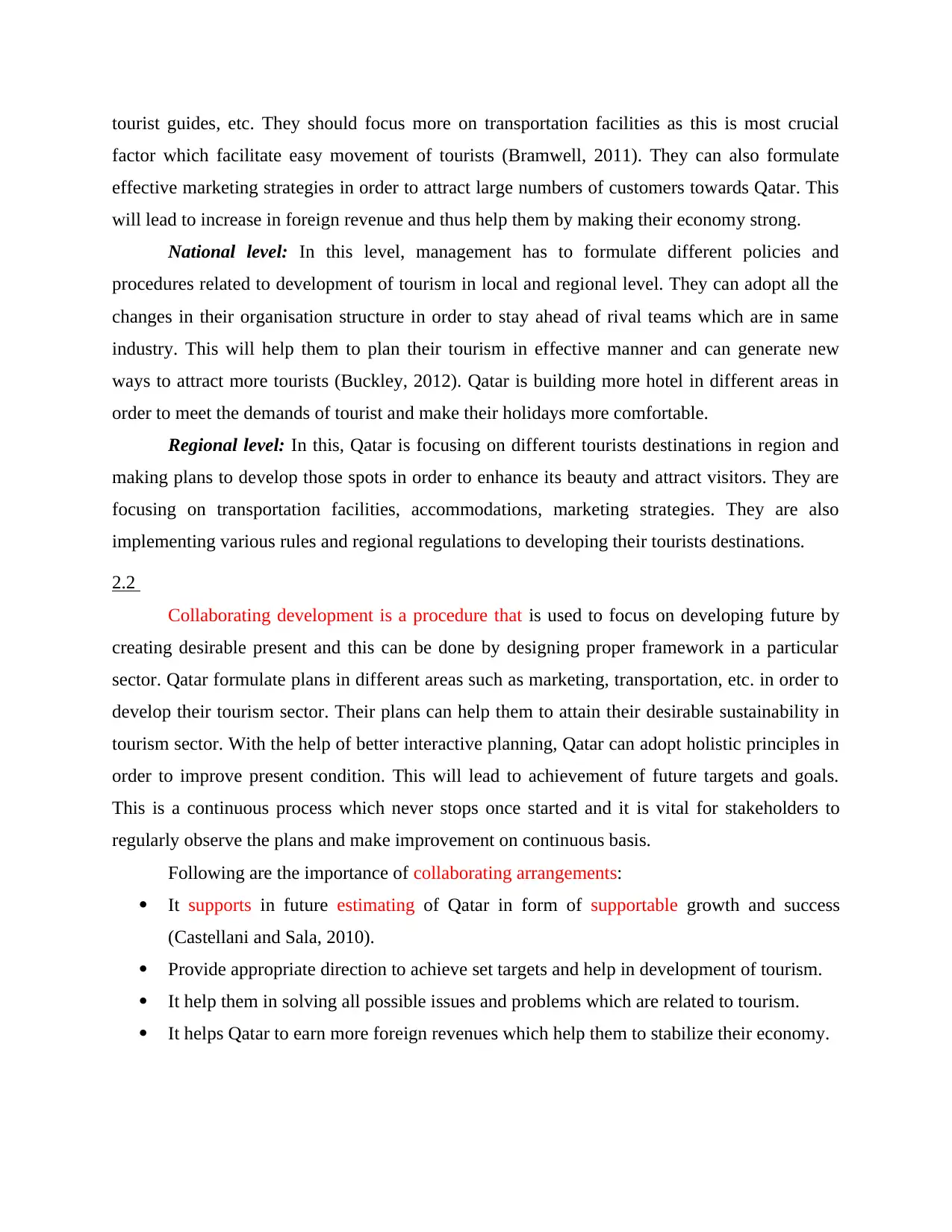
tourist guides, etc. They should focus more on transportation facilities as this is most crucial
factor which facilitate easy movement of tourists (Bramwell, 2011). They can also formulate
effective marketing strategies in order to attract large numbers of customers towards Qatar. This
will lead to increase in foreign revenue and thus help them by making their economy strong.
National level: In this level, management has to formulate different policies and
procedures related to development of tourism in local and regional level. They can adopt all the
changes in their organisation structure in order to stay ahead of rival teams which are in same
industry. This will help them to plan their tourism in effective manner and can generate new
ways to attract more tourists (Buckley, 2012). Qatar is building more hotel in different areas in
order to meet the demands of tourist and make their holidays more comfortable.
Regional level: In this, Qatar is focusing on different tourists destinations in region and
making plans to develop those spots in order to enhance its beauty and attract visitors. They are
focusing on transportation facilities, accommodations, marketing strategies. They are also
implementing various rules and regional regulations to developing their tourists destinations.
2.2
Collaborating development is a procedure that is used to focus on developing future by
creating desirable present and this can be done by designing proper framework in a particular
sector. Qatar formulate plans in different areas such as marketing, transportation, etc. in order to
develop their tourism sector. Their plans can help them to attain their desirable sustainability in
tourism sector. With the help of better interactive planning, Qatar can adopt holistic principles in
order to improve present condition. This will lead to achievement of future targets and goals.
This is a continuous process which never stops once started and it is vital for stakeholders to
regularly observe the plans and make improvement on continuous basis.
Following are the importance of collaborating arrangements:
It supports in future estimating of Qatar in form of supportable growth and success
(Castellani and Sala, 2010).
Provide appropriate direction to achieve set targets and help in development of tourism.
It help them in solving all possible issues and problems which are related to tourism.
It helps Qatar to earn more foreign revenues which help them to stabilize their economy.
factor which facilitate easy movement of tourists (Bramwell, 2011). They can also formulate
effective marketing strategies in order to attract large numbers of customers towards Qatar. This
will lead to increase in foreign revenue and thus help them by making their economy strong.
National level: In this level, management has to formulate different policies and
procedures related to development of tourism in local and regional level. They can adopt all the
changes in their organisation structure in order to stay ahead of rival teams which are in same
industry. This will help them to plan their tourism in effective manner and can generate new
ways to attract more tourists (Buckley, 2012). Qatar is building more hotel in different areas in
order to meet the demands of tourist and make their holidays more comfortable.
Regional level: In this, Qatar is focusing on different tourists destinations in region and
making plans to develop those spots in order to enhance its beauty and attract visitors. They are
focusing on transportation facilities, accommodations, marketing strategies. They are also
implementing various rules and regional regulations to developing their tourists destinations.
2.2
Collaborating development is a procedure that is used to focus on developing future by
creating desirable present and this can be done by designing proper framework in a particular
sector. Qatar formulate plans in different areas such as marketing, transportation, etc. in order to
develop their tourism sector. Their plans can help them to attain their desirable sustainability in
tourism sector. With the help of better interactive planning, Qatar can adopt holistic principles in
order to improve present condition. This will lead to achievement of future targets and goals.
This is a continuous process which never stops once started and it is vital for stakeholders to
regularly observe the plans and make improvement on continuous basis.
Following are the importance of collaborating arrangements:
It supports in future estimating of Qatar in form of supportable growth and success
(Castellani and Sala, 2010).
Provide appropriate direction to achieve set targets and help in development of tourism.
It help them in solving all possible issues and problems which are related to tourism.
It helps Qatar to earn more foreign revenues which help them to stabilize their economy.
Paraphrase This Document
Need a fresh take? Get an instant paraphrase of this document with our AI Paraphraser
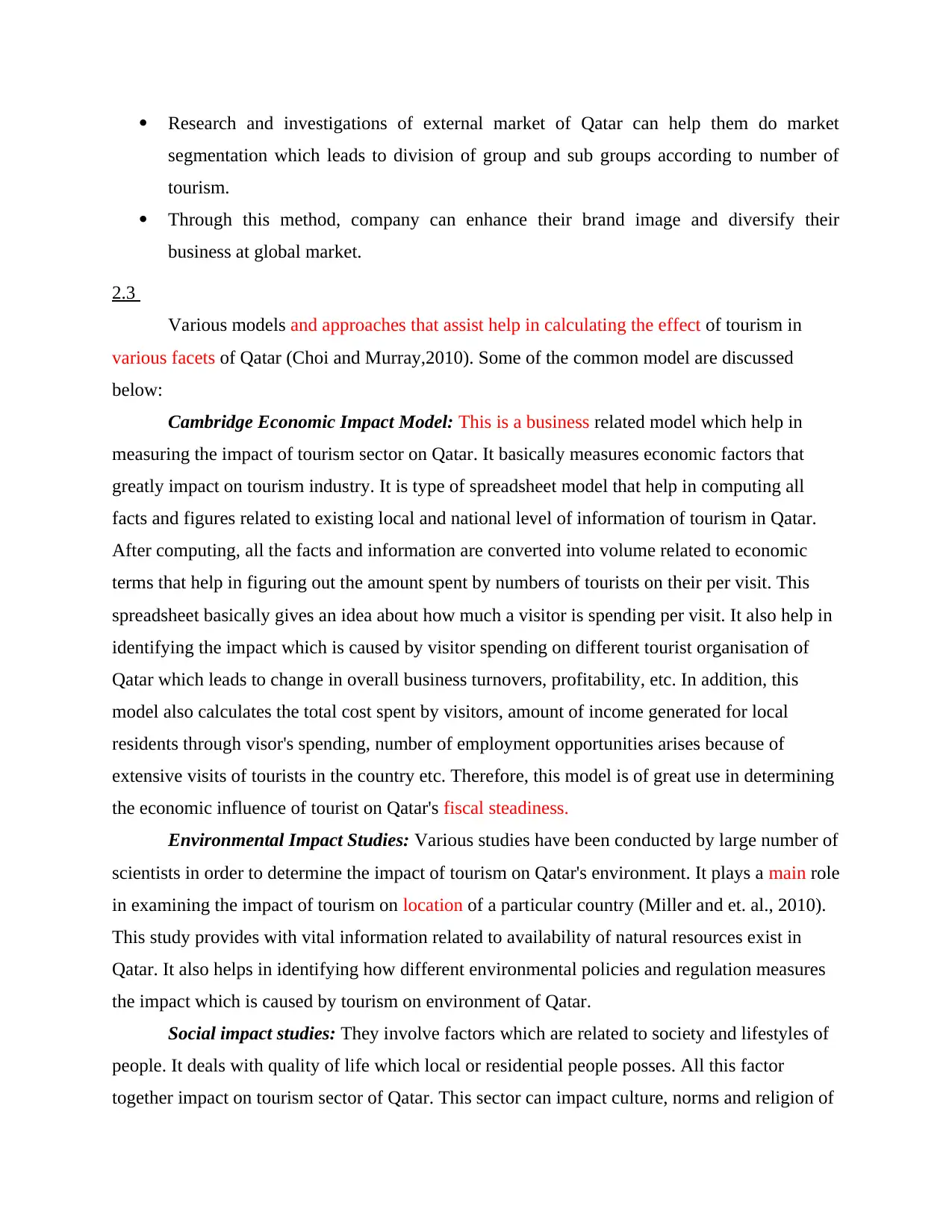
Research and investigations of external market of Qatar can help them do market
segmentation which leads to division of group and sub groups according to number of
tourism.
Through this method, company can enhance their brand image and diversify their
business at global market.
2.3
Various models and approaches that assist help in calculating the effect of tourism in
various facets of Qatar (Choi and Murray,2010). Some of the common model are discussed
below:
Cambridge Economic Impact Model: This is a business related model which help in
measuring the impact of tourism sector on Qatar. It basically measures economic factors that
greatly impact on tourism industry. It is type of spreadsheet model that help in computing all
facts and figures related to existing local and national level of information of tourism in Qatar.
After computing, all the facts and information are converted into volume related to economic
terms that help in figuring out the amount spent by numbers of tourists on their per visit. This
spreadsheet basically gives an idea about how much a visitor is spending per visit. It also help in
identifying the impact which is caused by visitor spending on different tourist organisation of
Qatar which leads to change in overall business turnovers, profitability, etc. In addition, this
model also calculates the total cost spent by visitors, amount of income generated for local
residents through visor's spending, number of employment opportunities arises because of
extensive visits of tourists in the country etc. Therefore, this model is of great use in determining
the economic influence of tourist on Qatar's fiscal steadiness.
Environmental Impact Studies: Various studies have been conducted by large number of
scientists in order to determine the impact of tourism on Qatar's environment. It plays a main role
in examining the impact of tourism on location of a particular country (Miller and et. al., 2010).
This study provides with vital information related to availability of natural resources exist in
Qatar. It also helps in identifying how different environmental policies and regulation measures
the impact which is caused by tourism on environment of Qatar.
Social impact studies: They involve factors which are related to society and lifestyles of
people. It deals with quality of life which local or residential people posses. All this factor
together impact on tourism sector of Qatar. This sector can impact culture, norms and religion of
segmentation which leads to division of group and sub groups according to number of
tourism.
Through this method, company can enhance their brand image and diversify their
business at global market.
2.3
Various models and approaches that assist help in calculating the effect of tourism in
various facets of Qatar (Choi and Murray,2010). Some of the common model are discussed
below:
Cambridge Economic Impact Model: This is a business related model which help in
measuring the impact of tourism sector on Qatar. It basically measures economic factors that
greatly impact on tourism industry. It is type of spreadsheet model that help in computing all
facts and figures related to existing local and national level of information of tourism in Qatar.
After computing, all the facts and information are converted into volume related to economic
terms that help in figuring out the amount spent by numbers of tourists on their per visit. This
spreadsheet basically gives an idea about how much a visitor is spending per visit. It also help in
identifying the impact which is caused by visitor spending on different tourist organisation of
Qatar which leads to change in overall business turnovers, profitability, etc. In addition, this
model also calculates the total cost spent by visitors, amount of income generated for local
residents through visor's spending, number of employment opportunities arises because of
extensive visits of tourists in the country etc. Therefore, this model is of great use in determining
the economic influence of tourist on Qatar's fiscal steadiness.
Environmental Impact Studies: Various studies have been conducted by large number of
scientists in order to determine the impact of tourism on Qatar's environment. It plays a main role
in examining the impact of tourism on location of a particular country (Miller and et. al., 2010).
This study provides with vital information related to availability of natural resources exist in
Qatar. It also helps in identifying how different environmental policies and regulation measures
the impact which is caused by tourism on environment of Qatar.
Social impact studies: They involve factors which are related to society and lifestyles of
people. It deals with quality of life which local or residential people posses. All this factor
together impact on tourism sector of Qatar. This sector can impact culture, norms and religion of
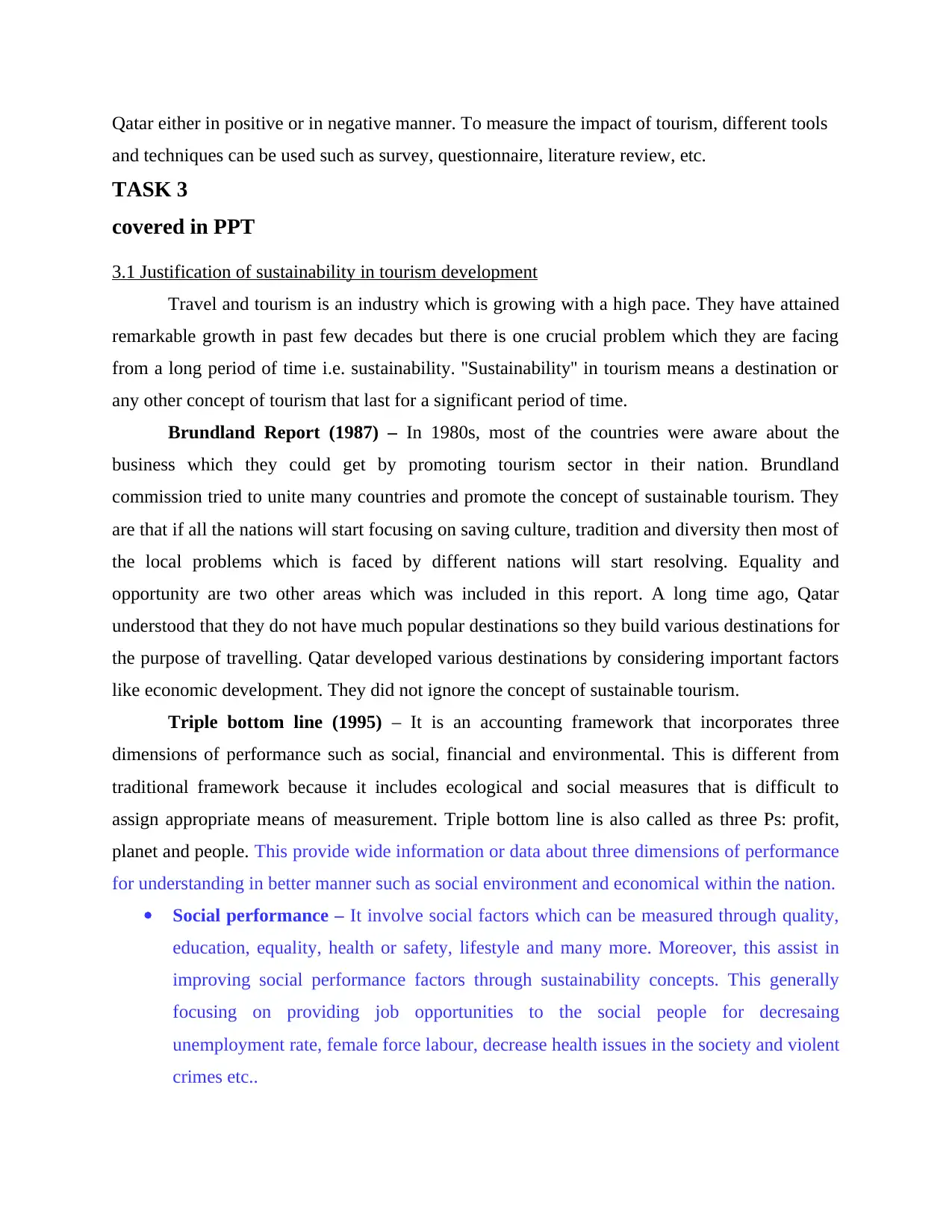
Qatar either in positive or in negative manner. To measure the impact of tourism, different tools
and techniques can be used such as survey, questionnaire, literature review, etc.
TASK 3
covered in PPT
3.1 Justification of sustainability in tourism development
Travel and tourism is an industry which is growing with a high pace. They have attained
remarkable growth in past few decades but there is one crucial problem which they are facing
from a long period of time i.e. sustainability. ''Sustainability'' in tourism means a destination or
any other concept of tourism that last for a significant period of time.
Brundland Report (1987) – In 1980s, most of the countries were aware about the
business which they could get by promoting tourism sector in their nation. Brundland
commission tried to unite many countries and promote the concept of sustainable tourism. They
are that if all the nations will start focusing on saving culture, tradition and diversity then most of
the local problems which is faced by different nations will start resolving. Equality and
opportunity are two other areas which was included in this report. A long time ago, Qatar
understood that they do not have much popular destinations so they build various destinations for
the purpose of travelling. Qatar developed various destinations by considering important factors
like economic development. They did not ignore the concept of sustainable tourism.
Triple bottom line (1995) – It is an accounting framework that incorporates three
dimensions of performance such as social, financial and environmental. This is different from
traditional framework because it includes ecological and social measures that is difficult to
assign appropriate means of measurement. Triple bottom line is also called as three Ps: profit,
planet and people. This provide wide information or data about three dimensions of performance
for understanding in better manner such as social environment and economical within the nation.
Social performance – It involve social factors which can be measured through quality,
education, equality, health or safety, lifestyle and many more. Moreover, this assist in
improving social performance factors through sustainability concepts. This generally
focusing on providing job opportunities to the social people for decresaing
unemployment rate, female force labour, decrease health issues in the society and violent
crimes etc..
and techniques can be used such as survey, questionnaire, literature review, etc.
TASK 3
covered in PPT
3.1 Justification of sustainability in tourism development
Travel and tourism is an industry which is growing with a high pace. They have attained
remarkable growth in past few decades but there is one crucial problem which they are facing
from a long period of time i.e. sustainability. ''Sustainability'' in tourism means a destination or
any other concept of tourism that last for a significant period of time.
Brundland Report (1987) – In 1980s, most of the countries were aware about the
business which they could get by promoting tourism sector in their nation. Brundland
commission tried to unite many countries and promote the concept of sustainable tourism. They
are that if all the nations will start focusing on saving culture, tradition and diversity then most of
the local problems which is faced by different nations will start resolving. Equality and
opportunity are two other areas which was included in this report. A long time ago, Qatar
understood that they do not have much popular destinations so they build various destinations for
the purpose of travelling. Qatar developed various destinations by considering important factors
like economic development. They did not ignore the concept of sustainable tourism.
Triple bottom line (1995) – It is an accounting framework that incorporates three
dimensions of performance such as social, financial and environmental. This is different from
traditional framework because it includes ecological and social measures that is difficult to
assign appropriate means of measurement. Triple bottom line is also called as three Ps: profit,
planet and people. This provide wide information or data about three dimensions of performance
for understanding in better manner such as social environment and economical within the nation.
Social performance – It involve social factors which can be measured through quality,
education, equality, health or safety, lifestyle and many more. Moreover, this assist in
improving social performance factors through sustainability concepts. This generally
focusing on providing job opportunities to the social people for decresaing
unemployment rate, female force labour, decrease health issues in the society and violent
crimes etc..
⊘ This is a preview!⊘
Do you want full access?
Subscribe today to unlock all pages.

Trusted by 1+ million students worldwide
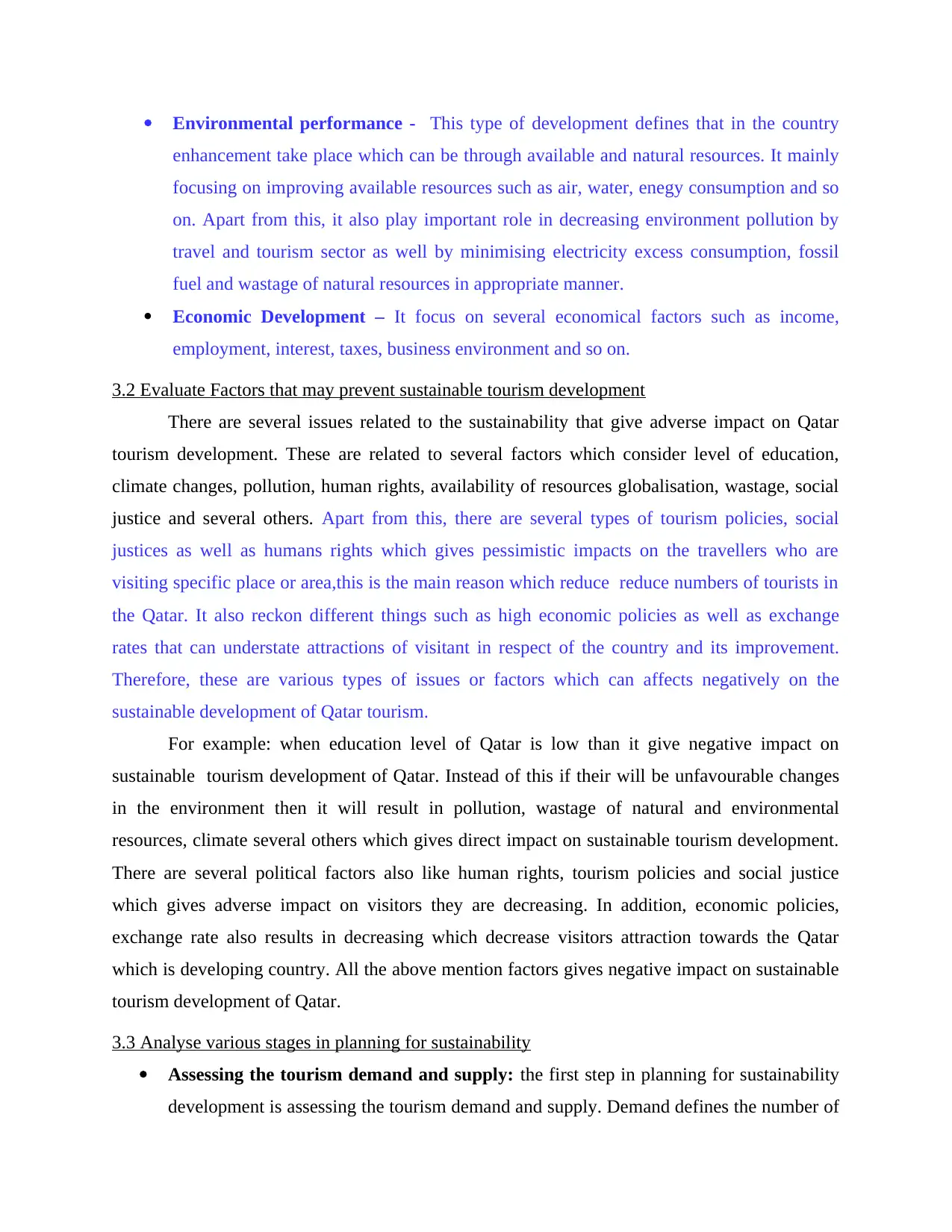
Environmental performance - This type of development defines that in the country
enhancement take place which can be through available and natural resources. It mainly
focusing on improving available resources such as air, water, enegy consumption and so
on. Apart from this, it also play important role in decreasing environment pollution by
travel and tourism sector as well by minimising electricity excess consumption, fossil
fuel and wastage of natural resources in appropriate manner.
Economic Development – It focus on several economical factors such as income,
employment, interest, taxes, business environment and so on.
3.2 Evaluate Factors that may prevent sustainable tourism development
There are several issues related to the sustainability that give adverse impact on Qatar
tourism development. These are related to several factors which consider level of education,
climate changes, pollution, human rights, availability of resources globalisation, wastage, social
justice and several others. Apart from this, there are several types of tourism policies, social
justices as well as humans rights which gives pessimistic impacts on the travellers who are
visiting specific place or area,this is the main reason which reduce reduce numbers of tourists in
the Qatar. It also reckon different things such as high economic policies as well as exchange
rates that can understate attractions of visitant in respect of the country and its improvement.
Therefore, these are various types of issues or factors which can affects negatively on the
sustainable development of Qatar tourism.
For example: when education level of Qatar is low than it give negative impact on
sustainable tourism development of Qatar. Instead of this if their will be unfavourable changes
in the environment then it will result in pollution, wastage of natural and environmental
resources, climate several others which gives direct impact on sustainable tourism development.
There are several political factors also like human rights, tourism policies and social justice
which gives adverse impact on visitors they are decreasing. In addition, economic policies,
exchange rate also results in decreasing which decrease visitors attraction towards the Qatar
which is developing country. All the above mention factors gives negative impact on sustainable
tourism development of Qatar.
3.3 Analyse various stages in planning for sustainability
Assessing the tourism demand and supply: the first step in planning for sustainability
development is assessing the tourism demand and supply. Demand defines the number of
enhancement take place which can be through available and natural resources. It mainly
focusing on improving available resources such as air, water, enegy consumption and so
on. Apart from this, it also play important role in decreasing environment pollution by
travel and tourism sector as well by minimising electricity excess consumption, fossil
fuel and wastage of natural resources in appropriate manner.
Economic Development – It focus on several economical factors such as income,
employment, interest, taxes, business environment and so on.
3.2 Evaluate Factors that may prevent sustainable tourism development
There are several issues related to the sustainability that give adverse impact on Qatar
tourism development. These are related to several factors which consider level of education,
climate changes, pollution, human rights, availability of resources globalisation, wastage, social
justice and several others. Apart from this, there are several types of tourism policies, social
justices as well as humans rights which gives pessimistic impacts on the travellers who are
visiting specific place or area,this is the main reason which reduce reduce numbers of tourists in
the Qatar. It also reckon different things such as high economic policies as well as exchange
rates that can understate attractions of visitant in respect of the country and its improvement.
Therefore, these are various types of issues or factors which can affects negatively on the
sustainable development of Qatar tourism.
For example: when education level of Qatar is low than it give negative impact on
sustainable tourism development of Qatar. Instead of this if their will be unfavourable changes
in the environment then it will result in pollution, wastage of natural and environmental
resources, climate several others which gives direct impact on sustainable tourism development.
There are several political factors also like human rights, tourism policies and social justice
which gives adverse impact on visitors they are decreasing. In addition, economic policies,
exchange rate also results in decreasing which decrease visitors attraction towards the Qatar
which is developing country. All the above mention factors gives negative impact on sustainable
tourism development of Qatar.
3.3 Analyse various stages in planning for sustainability
Assessing the tourism demand and supply: the first step in planning for sustainability
development is assessing the tourism demand and supply. Demand defines the number of
Paraphrase This Document
Need a fresh take? Get an instant paraphrase of this document with our AI Paraphraser
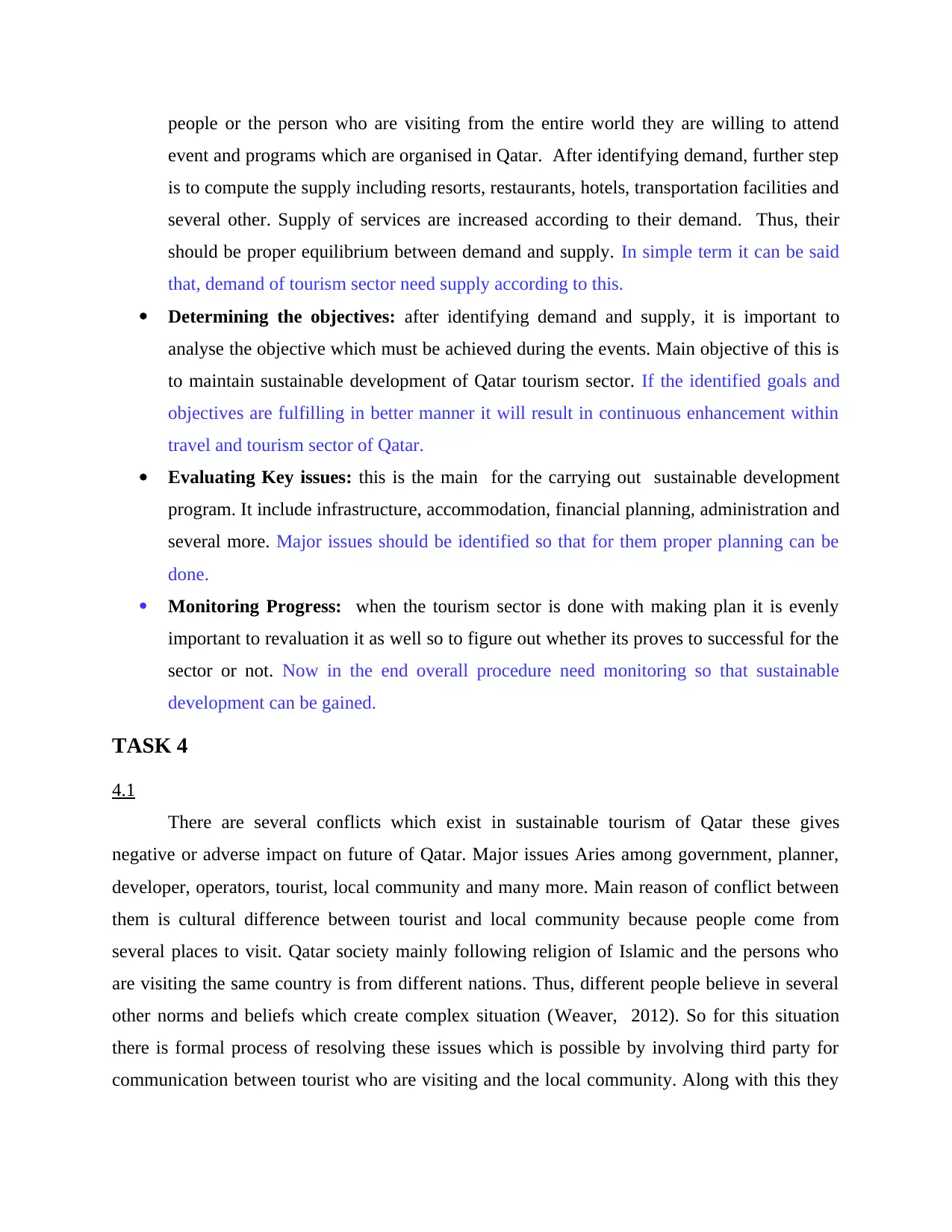
people or the person who are visiting from the entire world they are willing to attend
event and programs which are organised in Qatar. After identifying demand, further step
is to compute the supply including resorts, restaurants, hotels, transportation facilities and
several other. Supply of services are increased according to their demand. Thus, their
should be proper equilibrium between demand and supply. In simple term it can be said
that, demand of tourism sector need supply according to this.
Determining the objectives: after identifying demand and supply, it is important to
analyse the objective which must be achieved during the events. Main objective of this is
to maintain sustainable development of Qatar tourism sector. If the identified goals and
objectives are fulfilling in better manner it will result in continuous enhancement within
travel and tourism sector of Qatar.
Evaluating Key issues: this is the main for the carrying out sustainable development
program. It include infrastructure, accommodation, financial planning, administration and
several more. Major issues should be identified so that for them proper planning can be
done.
Monitoring Progress: when the tourism sector is done with making plan it is evenly
important to revaluation it as well so to figure out whether its proves to successful for the
sector or not. Now in the end overall procedure need monitoring so that sustainable
development can be gained.
TASK 4
4.1
There are several conflicts which exist in sustainable tourism of Qatar these gives
negative or adverse impact on future of Qatar. Major issues Aries among government, planner,
developer, operators, tourist, local community and many more. Main reason of conflict between
them is cultural difference between tourist and local community because people come from
several places to visit. Qatar society mainly following religion of Islamic and the persons who
are visiting the same country is from different nations. Thus, different people believe in several
other norms and beliefs which create complex situation (Weaver, 2012). So for this situation
there is formal process of resolving these issues which is possible by involving third party for
communication between tourist who are visiting and the local community. Along with this they
event and programs which are organised in Qatar. After identifying demand, further step
is to compute the supply including resorts, restaurants, hotels, transportation facilities and
several other. Supply of services are increased according to their demand. Thus, their
should be proper equilibrium between demand and supply. In simple term it can be said
that, demand of tourism sector need supply according to this.
Determining the objectives: after identifying demand and supply, it is important to
analyse the objective which must be achieved during the events. Main objective of this is
to maintain sustainable development of Qatar tourism sector. If the identified goals and
objectives are fulfilling in better manner it will result in continuous enhancement within
travel and tourism sector of Qatar.
Evaluating Key issues: this is the main for the carrying out sustainable development
program. It include infrastructure, accommodation, financial planning, administration and
several more. Major issues should be identified so that for them proper planning can be
done.
Monitoring Progress: when the tourism sector is done with making plan it is evenly
important to revaluation it as well so to figure out whether its proves to successful for the
sector or not. Now in the end overall procedure need monitoring so that sustainable
development can be gained.
TASK 4
4.1
There are several conflicts which exist in sustainable tourism of Qatar these gives
negative or adverse impact on future of Qatar. Major issues Aries among government, planner,
developer, operators, tourist, local community and many more. Main reason of conflict between
them is cultural difference between tourist and local community because people come from
several places to visit. Qatar society mainly following religion of Islamic and the persons who
are visiting the same country is from different nations. Thus, different people believe in several
other norms and beliefs which create complex situation (Weaver, 2012). So for this situation
there is formal process of resolving these issues which is possible by involving third party for
communication between tourist who are visiting and the local community. Along with this they
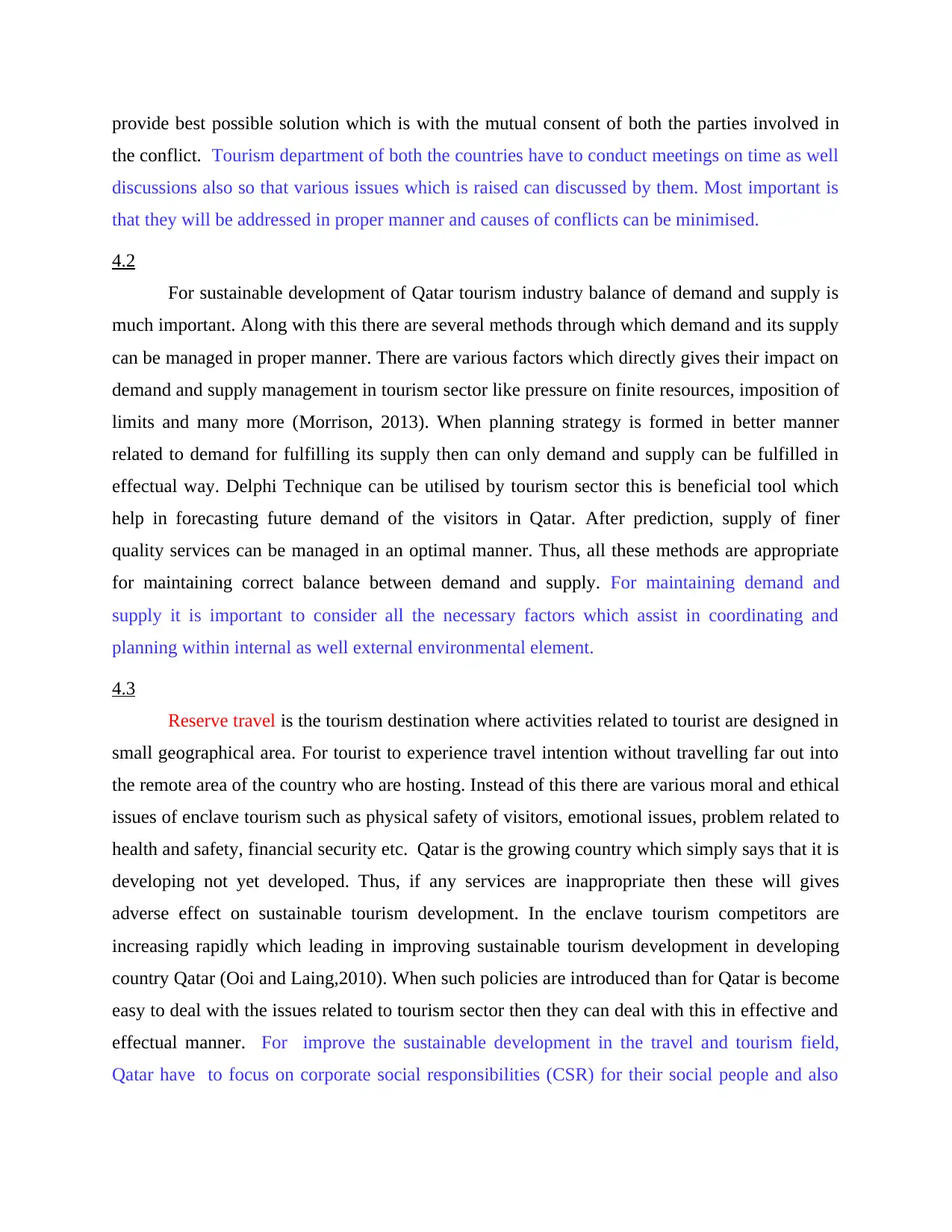
provide best possible solution which is with the mutual consent of both the parties involved in
the conflict. Tourism department of both the countries have to conduct meetings on time as well
discussions also so that various issues which is raised can discussed by them. Most important is
that they will be addressed in proper manner and causes of conflicts can be minimised.
4.2
For sustainable development of Qatar tourism industry balance of demand and supply is
much important. Along with this there are several methods through which demand and its supply
can be managed in proper manner. There are various factors which directly gives their impact on
demand and supply management in tourism sector like pressure on finite resources, imposition of
limits and many more (Morrison, 2013). When planning strategy is formed in better manner
related to demand for fulfilling its supply then can only demand and supply can be fulfilled in
effectual way. Delphi Technique can be utilised by tourism sector this is beneficial tool which
help in forecasting future demand of the visitors in Qatar. After prediction, supply of finer
quality services can be managed in an optimal manner. Thus, all these methods are appropriate
for maintaining correct balance between demand and supply. For maintaining demand and
supply it is important to consider all the necessary factors which assist in coordinating and
planning within internal as well external environmental element.
4.3
Reserve travel is the tourism destination where activities related to tourist are designed in
small geographical area. For tourist to experience travel intention without travelling far out into
the remote area of the country who are hosting. Instead of this there are various moral and ethical
issues of enclave tourism such as physical safety of visitors, emotional issues, problem related to
health and safety, financial security etc. Qatar is the growing country which simply says that it is
developing not yet developed. Thus, if any services are inappropriate then these will gives
adverse effect on sustainable tourism development. In the enclave tourism competitors are
increasing rapidly which leading in improving sustainable tourism development in developing
country Qatar (Ooi and Laing,2010). When such policies are introduced than for Qatar is become
easy to deal with the issues related to tourism sector then they can deal with this in effective and
effectual manner. For improve the sustainable development in the travel and tourism field,
Qatar have to focus on corporate social responsibilities (CSR) for their social people and also
the conflict. Tourism department of both the countries have to conduct meetings on time as well
discussions also so that various issues which is raised can discussed by them. Most important is
that they will be addressed in proper manner and causes of conflicts can be minimised.
4.2
For sustainable development of Qatar tourism industry balance of demand and supply is
much important. Along with this there are several methods through which demand and its supply
can be managed in proper manner. There are various factors which directly gives their impact on
demand and supply management in tourism sector like pressure on finite resources, imposition of
limits and many more (Morrison, 2013). When planning strategy is formed in better manner
related to demand for fulfilling its supply then can only demand and supply can be fulfilled in
effectual way. Delphi Technique can be utilised by tourism sector this is beneficial tool which
help in forecasting future demand of the visitors in Qatar. After prediction, supply of finer
quality services can be managed in an optimal manner. Thus, all these methods are appropriate
for maintaining correct balance between demand and supply. For maintaining demand and
supply it is important to consider all the necessary factors which assist in coordinating and
planning within internal as well external environmental element.
4.3
Reserve travel is the tourism destination where activities related to tourist are designed in
small geographical area. For tourist to experience travel intention without travelling far out into
the remote area of the country who are hosting. Instead of this there are various moral and ethical
issues of enclave tourism such as physical safety of visitors, emotional issues, problem related to
health and safety, financial security etc. Qatar is the growing country which simply says that it is
developing not yet developed. Thus, if any services are inappropriate then these will gives
adverse effect on sustainable tourism development. In the enclave tourism competitors are
increasing rapidly which leading in improving sustainable tourism development in developing
country Qatar (Ooi and Laing,2010). When such policies are introduced than for Qatar is become
easy to deal with the issues related to tourism sector then they can deal with this in effective and
effectual manner. For improve the sustainable development in the travel and tourism field,
Qatar have to focus on corporate social responsibilities (CSR) for their social people and also
⊘ This is a preview!⊘
Do you want full access?
Subscribe today to unlock all pages.

Trusted by 1+ million students worldwide
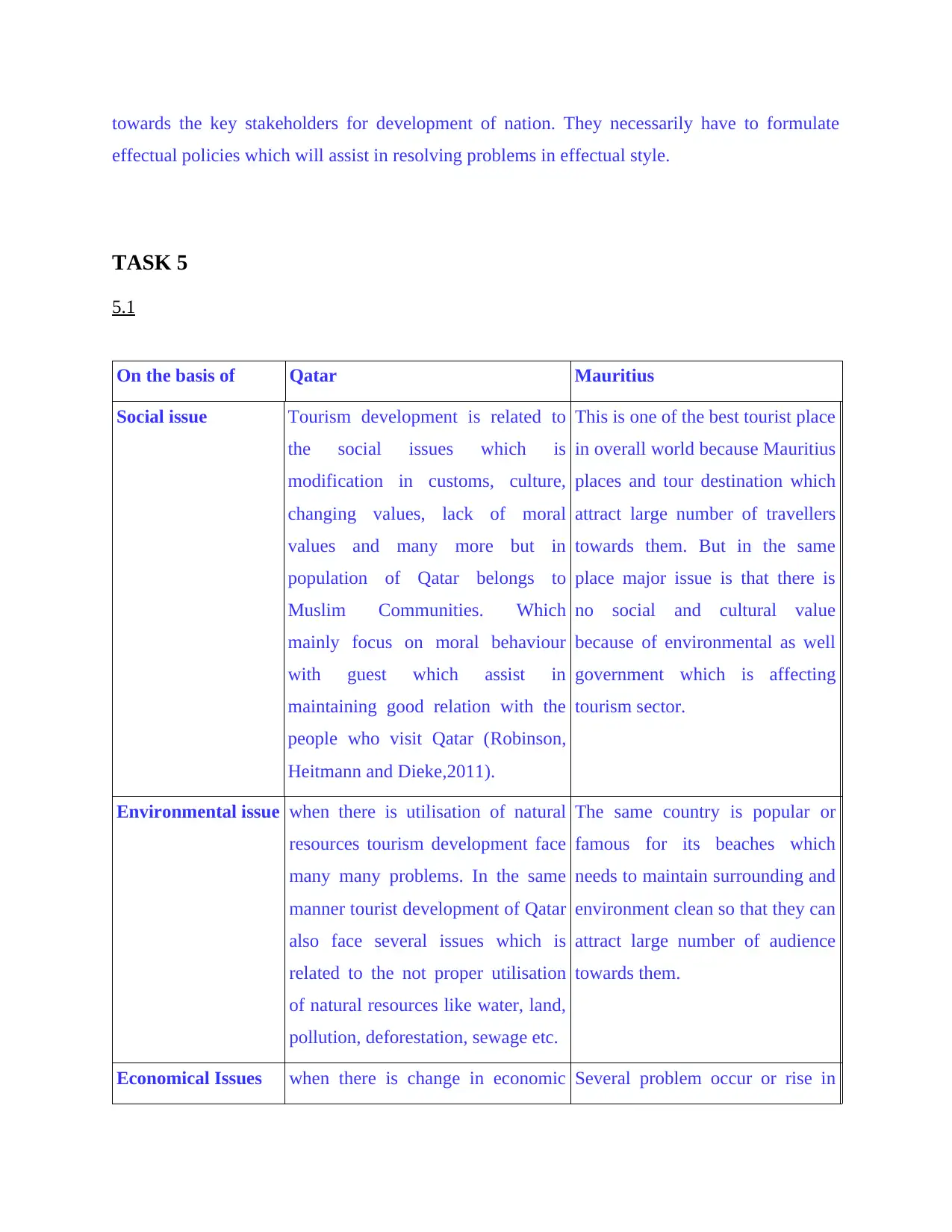
towards the key stakeholders for development of nation. They necessarily have to formulate
effectual policies which will assist in resolving problems in effectual style.
TASK 5
5.1
On the basis of Qatar Mauritius
Social issue Tourism development is related to
the social issues which is
modification in customs, culture,
changing values, lack of moral
values and many more but in
population of Qatar belongs to
Muslim Communities. Which
mainly focus on moral behaviour
with guest which assist in
maintaining good relation with the
people who visit Qatar (Robinson,
Heitmann and Dieke,2011).
This is one of the best tourist place
in overall world because Mauritius
places and tour destination which
attract large number of travellers
towards them. But in the same
place major issue is that there is
no social and cultural value
because of environmental as well
government which is affecting
tourism sector.
Environmental issue when there is utilisation of natural
resources tourism development face
many many problems. In the same
manner tourist development of Qatar
also face several issues which is
related to the not proper utilisation
of natural resources like water, land,
pollution, deforestation, sewage etc.
The same country is popular or
famous for its beaches which
needs to maintain surrounding and
environment clean so that they can
attract large number of audience
towards them.
Economical Issues when there is change in economic Several problem occur or rise in
effectual policies which will assist in resolving problems in effectual style.
TASK 5
5.1
On the basis of Qatar Mauritius
Social issue Tourism development is related to
the social issues which is
modification in customs, culture,
changing values, lack of moral
values and many more but in
population of Qatar belongs to
Muslim Communities. Which
mainly focus on moral behaviour
with guest which assist in
maintaining good relation with the
people who visit Qatar (Robinson,
Heitmann and Dieke,2011).
This is one of the best tourist place
in overall world because Mauritius
places and tour destination which
attract large number of travellers
towards them. But in the same
place major issue is that there is
no social and cultural value
because of environmental as well
government which is affecting
tourism sector.
Environmental issue when there is utilisation of natural
resources tourism development face
many many problems. In the same
manner tourist development of Qatar
also face several issues which is
related to the not proper utilisation
of natural resources like water, land,
pollution, deforestation, sewage etc.
The same country is popular or
famous for its beaches which
needs to maintain surrounding and
environment clean so that they can
attract large number of audience
towards them.
Economical Issues when there is change in economic Several problem occur or rise in
Paraphrase This Document
Need a fresh take? Get an instant paraphrase of this document with our AI Paraphraser
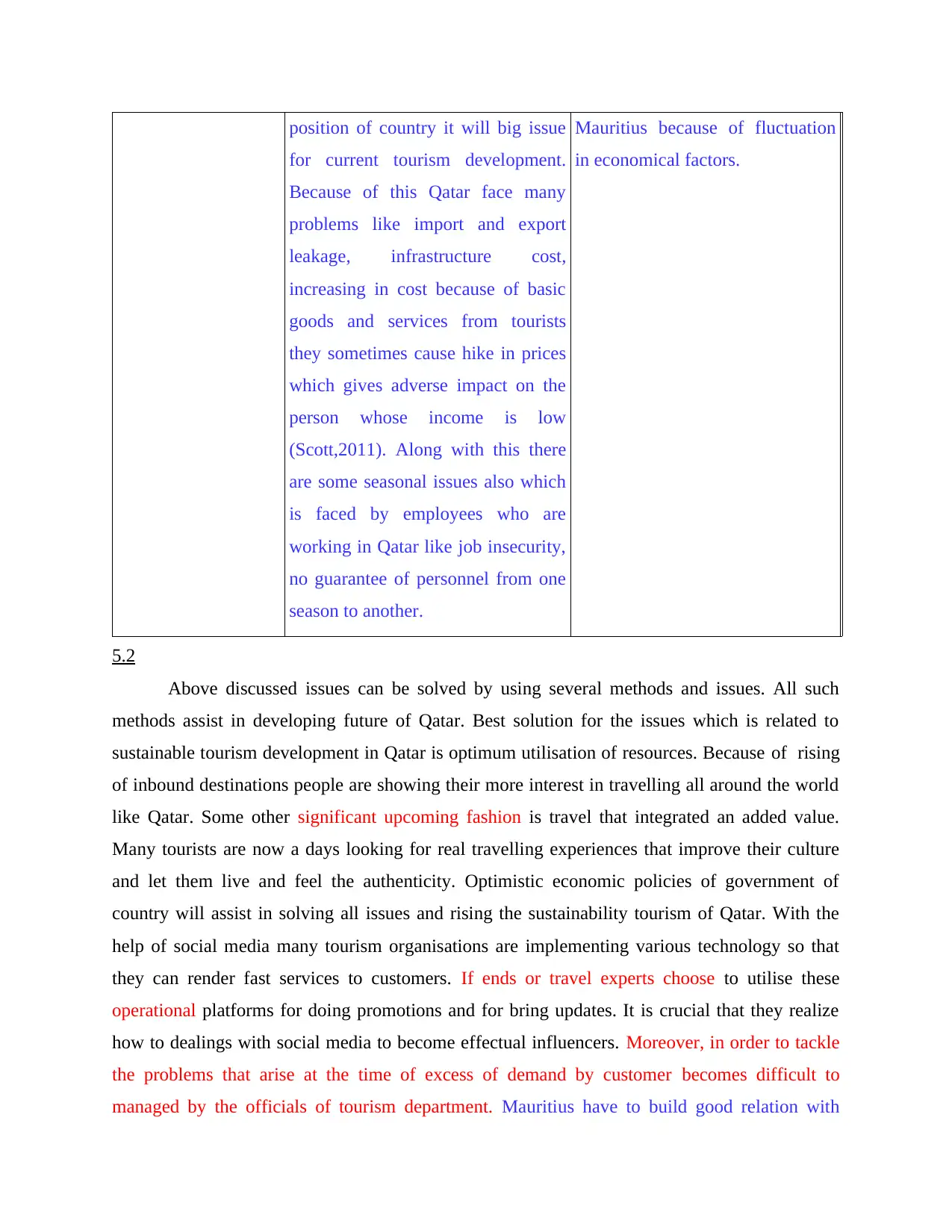
position of country it will big issue
for current tourism development.
Because of this Qatar face many
problems like import and export
leakage, infrastructure cost,
increasing in cost because of basic
goods and services from tourists
they sometimes cause hike in prices
which gives adverse impact on the
person whose income is low
(Scott,2011). Along with this there
are some seasonal issues also which
is faced by employees who are
working in Qatar like job insecurity,
no guarantee of personnel from one
season to another.
Mauritius because of fluctuation
in economical factors.
5.2
Above discussed issues can be solved by using several methods and issues. All such
methods assist in developing future of Qatar. Best solution for the issues which is related to
sustainable tourism development in Qatar is optimum utilisation of resources. Because of rising
of inbound destinations people are showing their more interest in travelling all around the world
like Qatar. Some other significant upcoming fashion is travel that integrated an added value.
Many tourists are now a days looking for real travelling experiences that improve their culture
and let them live and feel the authenticity. Optimistic economic policies of government of
country will assist in solving all issues and rising the sustainability tourism of Qatar. With the
help of social media many tourism organisations are implementing various technology so that
they can render fast services to customers. If ends or travel experts choose to utilise these
operational platforms for doing promotions and for bring updates. It is crucial that they realize
how to dealings with social media to become effectual influencers. Moreover, in order to tackle
the problems that arise at the time of excess of demand by customer becomes difficult to
managed by the officials of tourism department. Mauritius have to build good relation with
for current tourism development.
Because of this Qatar face many
problems like import and export
leakage, infrastructure cost,
increasing in cost because of basic
goods and services from tourists
they sometimes cause hike in prices
which gives adverse impact on the
person whose income is low
(Scott,2011). Along with this there
are some seasonal issues also which
is faced by employees who are
working in Qatar like job insecurity,
no guarantee of personnel from one
season to another.
Mauritius because of fluctuation
in economical factors.
5.2
Above discussed issues can be solved by using several methods and issues. All such
methods assist in developing future of Qatar. Best solution for the issues which is related to
sustainable tourism development in Qatar is optimum utilisation of resources. Because of rising
of inbound destinations people are showing their more interest in travelling all around the world
like Qatar. Some other significant upcoming fashion is travel that integrated an added value.
Many tourists are now a days looking for real travelling experiences that improve their culture
and let them live and feel the authenticity. Optimistic economic policies of government of
country will assist in solving all issues and rising the sustainability tourism of Qatar. With the
help of social media many tourism organisations are implementing various technology so that
they can render fast services to customers. If ends or travel experts choose to utilise these
operational platforms for doing promotions and for bring updates. It is crucial that they realize
how to dealings with social media to become effectual influencers. Moreover, in order to tackle
the problems that arise at the time of excess of demand by customer becomes difficult to
managed by the officials of tourism department. Mauritius have to build good relation with
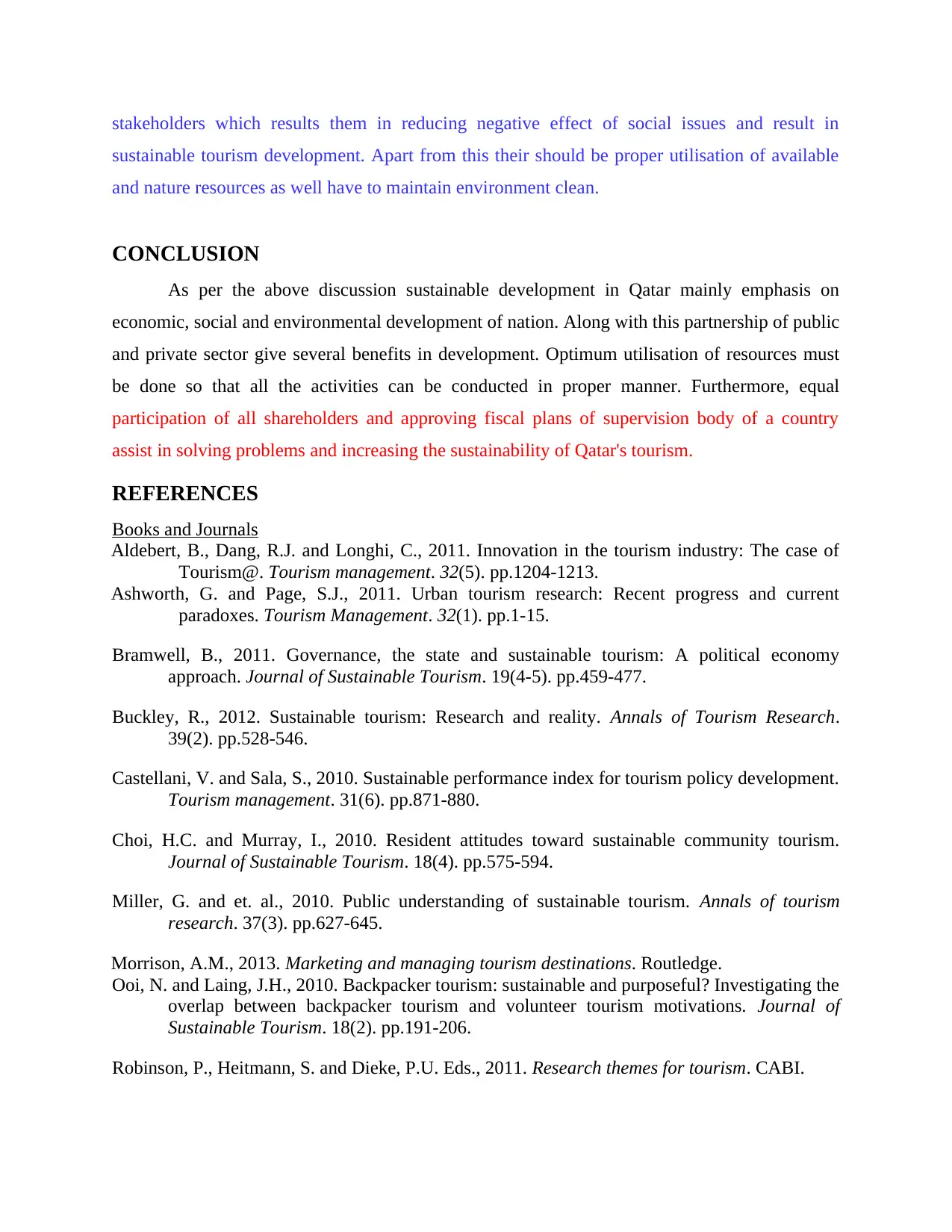
stakeholders which results them in reducing negative effect of social issues and result in
sustainable tourism development. Apart from this their should be proper utilisation of available
and nature resources as well have to maintain environment clean.
CONCLUSION
As per the above discussion sustainable development in Qatar mainly emphasis on
economic, social and environmental development of nation. Along with this partnership of public
and private sector give several benefits in development. Optimum utilisation of resources must
be done so that all the activities can be conducted in proper manner. Furthermore, equal
participation of all shareholders and approving fiscal plans of supervision body of a country
assist in solving problems and increasing the sustainability of Qatar's tourism.
REFERENCES
Books and Journals
Aldebert, B., Dang, R.J. and Longhi, C., 2011. Innovation in the tourism industry: The case of
Tourism@. Tourism management. 32(5). pp.1204-1213.
Ashworth, G. and Page, S.J., 2011. Urban tourism research: Recent progress and current
paradoxes. Tourism Management. 32(1). pp.1-15.
Bramwell, B., 2011. Governance, the state and sustainable tourism: A political economy
approach. Journal of Sustainable Tourism. 19(4-5). pp.459-477.
Buckley, R., 2012. Sustainable tourism: Research and reality. Annals of Tourism Research.
39(2). pp.528-546.
Castellani, V. and Sala, S., 2010. Sustainable performance index for tourism policy development.
Tourism management. 31(6). pp.871-880.
Choi, H.C. and Murray, I., 2010. Resident attitudes toward sustainable community tourism.
Journal of Sustainable Tourism. 18(4). pp.575-594.
Miller, G. and et. al., 2010. Public understanding of sustainable tourism. Annals of tourism
research. 37(3). pp.627-645.
Morrison, A.M., 2013. Marketing and managing tourism destinations. Routledge.
Ooi, N. and Laing, J.H., 2010. Backpacker tourism: sustainable and purposeful? Investigating the
overlap between backpacker tourism and volunteer tourism motivations. Journal of
Sustainable Tourism. 18(2). pp.191-206.
Robinson, P., Heitmann, S. and Dieke, P.U. Eds., 2011. Research themes for tourism. CABI.
sustainable tourism development. Apart from this their should be proper utilisation of available
and nature resources as well have to maintain environment clean.
CONCLUSION
As per the above discussion sustainable development in Qatar mainly emphasis on
economic, social and environmental development of nation. Along with this partnership of public
and private sector give several benefits in development. Optimum utilisation of resources must
be done so that all the activities can be conducted in proper manner. Furthermore, equal
participation of all shareholders and approving fiscal plans of supervision body of a country
assist in solving problems and increasing the sustainability of Qatar's tourism.
REFERENCES
Books and Journals
Aldebert, B., Dang, R.J. and Longhi, C., 2011. Innovation in the tourism industry: The case of
Tourism@. Tourism management. 32(5). pp.1204-1213.
Ashworth, G. and Page, S.J., 2011. Urban tourism research: Recent progress and current
paradoxes. Tourism Management. 32(1). pp.1-15.
Bramwell, B., 2011. Governance, the state and sustainable tourism: A political economy
approach. Journal of Sustainable Tourism. 19(4-5). pp.459-477.
Buckley, R., 2012. Sustainable tourism: Research and reality. Annals of Tourism Research.
39(2). pp.528-546.
Castellani, V. and Sala, S., 2010. Sustainable performance index for tourism policy development.
Tourism management. 31(6). pp.871-880.
Choi, H.C. and Murray, I., 2010. Resident attitudes toward sustainable community tourism.
Journal of Sustainable Tourism. 18(4). pp.575-594.
Miller, G. and et. al., 2010. Public understanding of sustainable tourism. Annals of tourism
research. 37(3). pp.627-645.
Morrison, A.M., 2013. Marketing and managing tourism destinations. Routledge.
Ooi, N. and Laing, J.H., 2010. Backpacker tourism: sustainable and purposeful? Investigating the
overlap between backpacker tourism and volunteer tourism motivations. Journal of
Sustainable Tourism. 18(2). pp.191-206.
Robinson, P., Heitmann, S. and Dieke, P.U. Eds., 2011. Research themes for tourism. CABI.
⊘ This is a preview!⊘
Do you want full access?
Subscribe today to unlock all pages.

Trusted by 1+ million students worldwide
1 out of 13
Related Documents
Your All-in-One AI-Powered Toolkit for Academic Success.
+13062052269
info@desklib.com
Available 24*7 on WhatsApp / Email
![[object Object]](/_next/static/media/star-bottom.7253800d.svg)
Unlock your academic potential
Copyright © 2020–2025 A2Z Services. All Rights Reserved. Developed and managed by ZUCOL.





